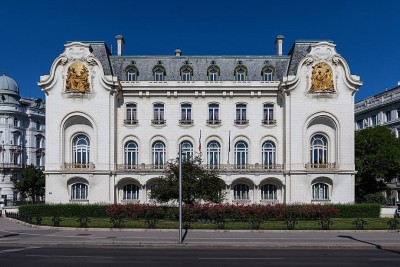Everything You Always Wanted to Know About the French Embassy Building in Vienna
The French Embassy in Vienna is located in a palace on Schwarzenbergplatz and is considered unique worldwide with its "Art Nouveau" style. The beautiful building can look back on a history of over 100 years. Learn more about this historical building.
 The French Embassy in Vienna at Technikerstraße 4. / Picture: © Wikimedia Commons, Thomas Wolf, www.foto-tw.de, CC BY-SA 3.0 DE
The French Embassy in Vienna at Technikerstraße 4. / Picture: © Wikimedia Commons, Thomas Wolf, www.foto-tw.de, CC BY-SA 3.0 DE
The French Embassy in Vienna is located in a palace at Technikerstraße 4, just off Schwarzenbergplatz. What is particularly noteworthy about it is that it is the only diplomatic representation in the world built in the "Art Nouveau" style.
The "Art Nouveau" architectural style is considered a homage to modernism, such as Viennese Art Nouveau, among others, and a symbol of the power and greatness of France during the Third Republic, as well as a sign of appreciation for the Austro-Hungarian monarchy.
The planning of the embassy building was begun in 1901 by the then respected Parisian architect Georges-Paul Chedanne, who had already won the Grand Prix de Rome a few years earlier in 1887. At that time, the French Foreign Ministry commissioned him with the prestigious task of creating a concept for the new embassy and carrying out the construction.
Interesting detail: For many years, there has been a legend that the original building plan for the embassy was drawn up in Istanbul. However, the French Embassy is able to debunk this rumour on its website, as the plans of the architect Georges-Paul Chedanne clearly refer to the triangular shape of the Scharzenbergplatz site - the place where it is located. Thus, it can be strongly assumed that these designs were created specifically for Vienna.
For the unusnual triangular plot, Chedanne designed a building that displays a magnificent façade towards Schwarzenbergplatz, but which is not interrupted by an entrance. Instead, he moved the main access to the embassy to the back of the building, where also - in an outbuilding in the "apex" of the triangle - the stables were built, which today serve as a press centre and garage.
The sumptuous furnishings of the Embassy, which include exquisite classical pieces such as tapestries from the Gobelin Manufacture, were provided in part by the National Movables Archive, the Musée d'Orsay and the National Contemporary Art Fund.
Numerous objects were designed and created especially for this embassy by France's most renowned artists and craftsmen - for example, some of the tableware, vases and ornamental objects from the Sèvres Manufacture.
The construction of the embassy was finally approved in 1904, but the plans were repeatedly revised in 1907 and 1908, so that the building could not be handed over until 1909.
For his part, a contemporary ambassador had little love for the style of the new embassy, denigrating the building as tasteless and criticising its lack of harmony with the style of the House of Habsburg.
The problems, however, had only just begun. In the course of the First World War, more and more criticism of the style of the building arose, and towards the end of the war, even the sale of the building was considered, which was ultimately rejected.
Today, the style is seen with different eyes and people are proud of its uniqueness. Preserving this elegant building as an exceptional testimony to French "Art Nouveau" is a special concern of the French Embassy in Vienna and the departments of the Ministry of Foreign Affairs specially set up to look after the cultural heritage.



